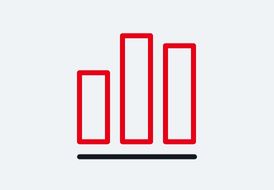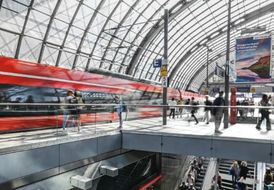Air quality control
Absolute airborne pollutants as of Dec 31 / t | 2022 | 2021 | 2020 |
Particulate emissions | 3,862 | 5,299 | 5,758 |
Nitrogen oxide (NOX) emissions | 92,699 | 105,079 | 102,324 |
Sulfur dioxide (SO₂) emissions | 19,729 | 14,651 | 13,350 |
Hydrocarbon (NMHC) emissions | 7,865 | 7,782 | 7,203 |
Combustion-related, well-to-wheel (WTW), Scopes 1 –3.
Up to and including 2020, excluding rail freight transport from/to China by DB Cargo and DB Schenker.
Since 2022, including stationary combustion processes and correction of the mathematical overestimation of SO₂ reduction in ocean freight.
The ongoing modernization of our vehicle fleet is our most important measure for reducing airborne pollutants. The high proportion of electrically powered rail transport also makes an important contribution, as electric rolling stock does not produce any local air pollutant emissions apart from abrasion, but only during power generation. The calculation is based on the fuel consumption and composition of our vehicle fleets. We have been exclusively using low-emissions construction vehicles and machinery at our urban construction sites since mid-2018. Our combustion-related pollutant emissions are largely influenced by our ocean freight activities, which emit over 68% of soot particles. We are continuing our cooperation with the carriers in this area in various industry forums, where the phasing out of fossil fuels is also being jointly addressed. In addition, stricter statutory regulations on sulfur content in fuels to reduce airborne pollutants have been in force worldwide in shipping since January 2020. Due to the overly optimistic consideration of this legal intensification in 2020 and 2021, and its correction in 2022, SO₂ emissions appear to rise in 2022.
Emissions standards for our vehicles
Our rail and road vehicles meet current Euro standards and thus ensure a lower level of pollutant emissions. Our trucks used in long-distance transport comply with the strictest emissions standards, Euro 5 and 6, and our entire car fleet meets the Euro 6 emissions standard. Since 2020, around 16% of the vehicles in our rail transport fleet have had the lowest pollutant level UIC 0. The proportion of rolling stock with low-pollutant electric traction remains at a high level at around 62%. The share of our buses meeting the Euro 5 and 6 standards increased to around 88% (previous year: around 82%).
Methodology
The accounting principles are the Group-wide and aggregated final energy consumption and performance data as well as relevant emission factors (Emissionsfaktoren, EFA). We take into account the distribution of our fleets according to the pollutant standard in calculating the EFA. In addition, we use limit values for rolling stock (EU Directive 97/68/EC, EU Directive 2004/26/EC, EU Regulation 2016/1628), the TREMOD emissions calculation model, the EcoTransIT World accounting tool and our own calculations. Stationary emissions are accounted based on EFA, which are provided for DB Group by the Institute for Energy and Environmental Research Heidelberg (Institut für Energie- und Umweltforschung Heidelberg, ifeu).


